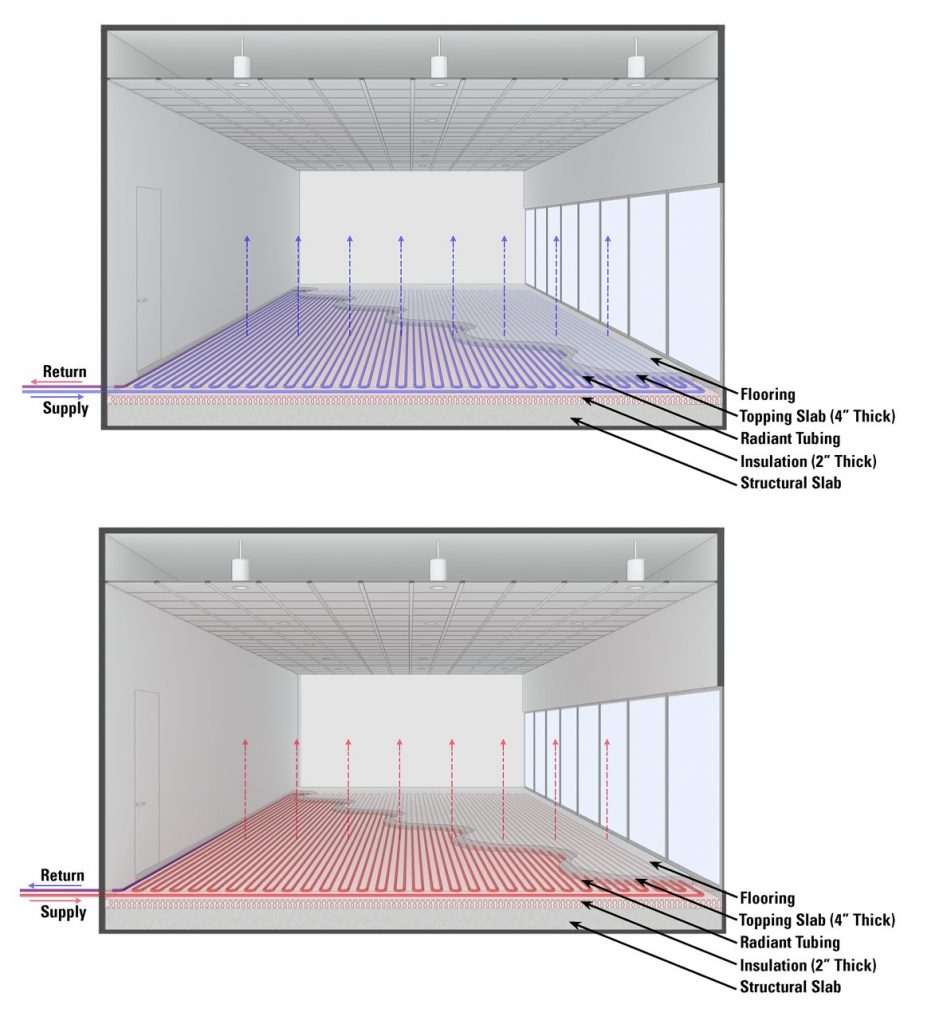At this point, a lot of digital ink has been spent discussing the benefits of radiant heating and cooling systems in the built environment. Traditional forced-air systems, while cheaper to install, use more energy to properly condition a space. Radiant solutions often recommended by MEP engineering experts because they are more effective in providing and controlling occupant comfort than forced-air systems.
However, there remains a significant hesitation toward integrating radiant technology across building market sectors, due in large part to higher upfront costs of installation. For example, the addition of radiant slabs may add about $10/sq.ft. on average to up-front costs of a traditional mechanical system. However, there are several downline avenues for return on investment that offer owners the opportunity to recoup that cost.
“At $34.19/sq.ft., re-purposing the saved areas as usable leasing space instead of mechanical rooms added up to an additional $302,000 in annual non-energy benefits.”
A major benefit to radiant, which we’ve discovered in our own work, comes from the space saved by reduced equipment size. The use of radiant technologies drives down energy consumption of a building and reduces space taken up by the HVAC system by piping water through the building instead of ducting air. Radiant systems do not completely eliminate the need for ductwork in a building – ventilation is still required by code to bring fresh air into the building. Radiant systems are often coupled with dedicated outside air systems to provide code-required ventilation air to the building, and to decrease the incidence of “dead zones” due to stagnant air. However, the use of radiant technologies drastically decreases the amount of space needed for ductwork as well as associated up-front and installation costs for air-side material. Pipe risers take up less space than shafts at the building core, increasing valuable rentable square footage for building owners. Glumac’s MEP engineering team performed an analysis on the 500,000 sq.ft. Edith Green-Wendell Wyatt building modernization project in Portland, Oregon, and found that using radiant technology saved 8,833 sq.ft. in mechanical space. At $34.19/sq.ft., re-purposing the saved areas as usable leasing space instead of mechanical rooms added up to an additional $302,000 in annual nonenergy benefits. Over the lifetime of a building, this can add up to significant returns.

Radiant cooling and heating involves piping chilled water or hot water through a material that can transfer heat effectively in the space. This method is most commonly extended to chilled sails, in-floor radiant slab, radiant ceiling panels, and radiant walls. Piping water through these materials requires significantly less transport energy than moving air with a forced-air system. Additionally, the air-side of an HVAC system is decreased in a radiant application, thereby decreasing fan and duct sizes, further decreasing the energy usage of the system. This creates sustained and predictable savings on monthly energy bills.
“The radiant heating and cooling system we designed at City Creek Center in Salt Lake City, provides a measured annual energy savings of 24% compared to a typical retail center.”
For example, the radiant system Glumac’s MEP engineering team designed at City Creek Center in Salt Lake City, Utah, provides a measured annual energy savings of 24% compared to a typical retail center in the same climate zone. The main shopping concourse features radiant heating and cooling, designed to condition with natural ventilation, heat with passive solar heating through operable skylights, and provide forced air heating and cooling at the very extreme ambient temperature conditions. The site is in full radiant and natural ventilation mode for 84% of the year, utilizing the forced-air systems for full cooling only 6% and full heating 10% of the year. The radiant system enabled the owner to dramatically decrease the carbon footprint of the site while creating a comfortable shopping environment.
As we continue to push for sustainable building design approaches, the business case remains a crucial part of the conversation. The radiant approach provides various possibilities for return on investment for owners through energy savings and by increasing usable leasing square-footage, as well as reducing space taken up by the mechanical system. But what’s more, this approach comes with the added benefit of increases to occupant health and productivity – a subject we will touch on in part two of this article.

